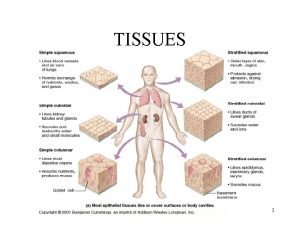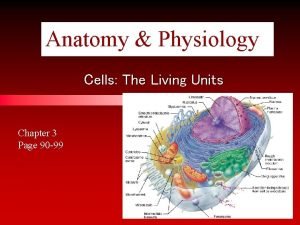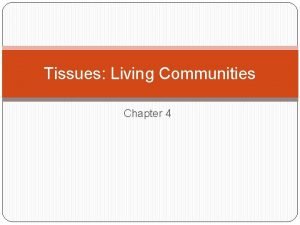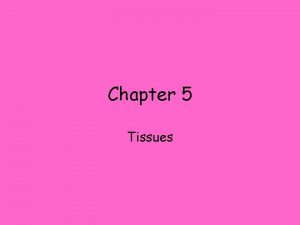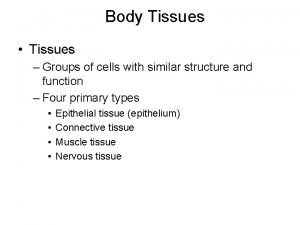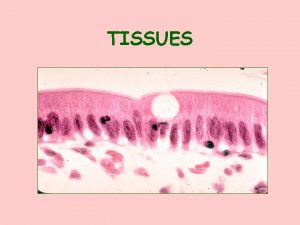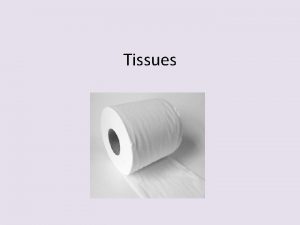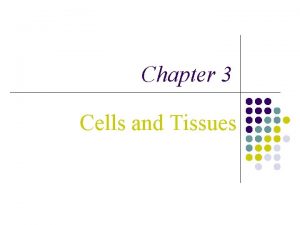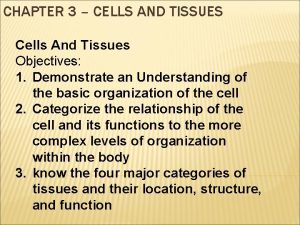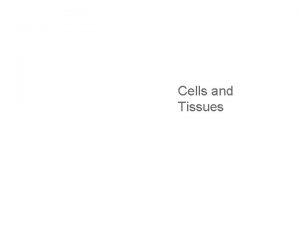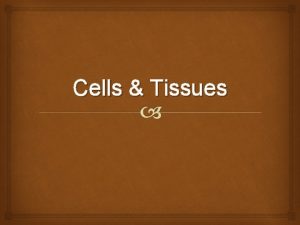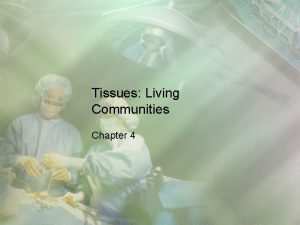Tissues Living Communities Chapter 5 Cells of similar






















- Slides: 22

Tissues: Living Communities Chapter 5

Cells of similar ______ and _______ cluster together to form tissues. Epithelial tissue Covers and lines Connective tissue Provides support Muscle tissue Enables movement Nervous tissue Controls work The study of microscopic structures of tissues and organs is called ______.

Characteristics of Epithelia Sheets of cells that cover and line other tissues. Cover the surface of organs and also lines the lumen of hollow organs. Can be composed of a single layer or multiple layers. ____ - Each epithelial cell has an apical surface and a basal surface. Apical surfaces the lumen or environment Basal surfaces the underlying connective tissue Epithelial cells are _________ and _________.

Junctional Complexes – specialized attachments between epithelial cells on their lateral surfaces. • Tight junctions • Prevent ______ • Ex: Bladder • Desmosomes • Tough, resist ______ and stretching (like Velcro). Consist of intermediate fibers • Ex: Uterus • Gap junctions • Cytoplasm continuous between cells • Linked by tubular channel proteins called ________. • Allow exchange of ions, nutrients, and transport signals • Ex: Cardiac muscle

Epithelial Cells: Basement Membrane Foundation of epithelial cells Fibers that cement epithelial cells to underlying __________ tissue Also called basal _____ Oxygen and nutrients diffuse up to epithelium through the basement membrane from the connective tissue. Absorbed substances and waste products produced by epithelium diffuse down through basement membrane to the connective tissue.

Cell surfaces can be smooth, but may contain ________ or _____. Cilia are found in respiratory and reproductive tracts. Microvilli are in intestines and urinary tract. If the cell contains microvilli, it is said to have a ______ border. Increases _______ area, which aids in absorption. Epithelial cells of the skin are filled with a waterproof protein called _____. Surface Specialization

Classifications of Epithelia NUMBER OF CELL LAYERS. Single layer is called _____ More than one layer is called _____ SHAPE OF CELLS. Squamous, cuboidal, and columnar If there is more than one layer, the name is based on shape of top layer of cells. PRESENCE OF CILIA OR MICROVILLI.


Simple Squamous Epithelium Flat and smooth; reduces friction Often found lining surfaces involved in the passage of either ______ or _____ ENDOTHELIUM, ALVEOLI OF LUNGS

Simple Cuboidal Epithelium • Round, dark-staining nuclei aligned in a single row. • Square-shaped cells. • GLANDS (endocrine and exocrine)

Simple Columnar Epithelium Elongated cells with elongated nuclei that are aligned in a row at the base of the cell. Lines DIGESTIVE TRACT from stomach to rectum ______ cell- apical surface is blanketed by microvilli that increase the surface area for absorption of food. ______ cellmanufacture and store mucin (component of mucus) for

Stratified Squamous Epithelium Multilayered Cuboidal cells are attached to the basement membrane. As they mature, they are pushed to the surface away from nutrients. Lose their cytoplasm and nuclei and become squamous. Top layer is worn away/sloughed off MOUTH, VAGINA, ANUS, SKIN (keratinized) (Areas of wear and tear)

• “_____” stratified – truly a simple epithelium • Cell nuclei are found at different levels across the length of the tissue • Some cells do not reach luminal surface, but ALL attach to basement membrane. • Usually ______ and often associated with _____ cells. • Found in RESPIRATORY TRACT Pseudostratified Columnar Epithelium

Transitional Epithelium Stratified epithelium Basal layer of cuboidal or columnar cells Superficial layer of cuboidal cells (domelike) Ability to ______ URINARY TRACT leak-proof As epithelia stretches, layers thin depending on how much volume is present

Gland- cells that manufacture and discharge large amounts of secretions from the Golgi apparatus. Glandular epithelial cells have prominent ER, Golgi Glands form in utero. A layer of epithelial cells folds inward. Form _________ that lead to the epithelial surface. Some glands (_______) become separated from the original epithelium. Glandular Epithelia

Endocrine Glands NO DUCTS (cells die) Produce and secrete _______. Blood stream delivers secretions to entire body _______ within the gland bring secretions to the circulatory system

Contain ducts (except for _____ cells) Have local effect. Discharge secretions via ducts directly into nearby areas. Secretions act locally and do not enter into the circulatory system Examples of secretions: Saliva Bile Pancreatic and liver digestive enzymes Sweat Egg/Sperm Exocrine Glands

• Only unicellular exocrine gland • _______less • Composed of a modified ________ epithelial cell. • Secretes _____: (polysaccharides, proteins, and glycoproteins) • when mixed with water → mucus • Mucus functions to lubricate. It also traps microorganisms and foreign particles. Unicellular Exocrine Gland: Goblet Cell

Multicellular Exocrine Glands Contain 2 distinct components: 1) ________ Unit Secretory cells surrounded by connective tissue rich in blood vessels and nerve fibers that provides nourishment and structural support to the unit. 2) ____ carries secretion to its deposit site _____epithelial cells may be present that assist with the discharge of secretions into the glandular duct.

If main duct is unbranched, the gland is ______ If main duct is branched, gland is _______ If secretory cells form a long channel of even width, gland is ______ If cells form a rounded sac, it is ______ or acinar Glands with both tubular and alveolar qualities are tubuloalveolar or tubuloacinar Classification of Multicellular Exocrine Glands: Shape

Classification of Exocrine Glands: Manner of Secretion ________ Cells package their secretions and release them as they are manufactured Cell remains intact Majority of glands ________ Cells store their secretions in the apex after they are manufactured. When apex is full, it is pinched off and released with the secretions into the duct system. Cell is repaired and process is repeated. ________ Cells store their secretions until they are needed. The cell lyses, releasing its contents. Cell dies and is replaced via mitosis.

 Body tissue
Body tissue The four major categories of tissues are
The four major categories of tissues are Body tissues chapter 3 cells and tissues
Body tissues chapter 3 cells and tissues Body tissues chapter 3 cells and tissues
Body tissues chapter 3 cells and tissues Cells form tissues. tissues form __________.
Cells form tissues. tissues form __________. Tissues are groups of similar cells working together to
Tissues are groups of similar cells working together to Tissues are groups of similar cells working together to
Tissues are groups of similar cells working together to Tissues are groups of similar cells working together to:
Tissues are groups of similar cells working together to: Chapter 3 cells and tissues figure 3-7
Chapter 3 cells and tissues figure 3-7 Cell membrane phospholipids
Cell membrane phospholipids Smooth endoplasmic
Smooth endoplasmic Plant succession
Plant succession Cells-tissues-organ-systems-organism
Cells-tissues-organ-systems-organism Nondisjunction in meiosis
Nondisjunction in meiosis Chapter 3 cells the living units
Chapter 3 cells the living units Chapter 3 cells the living units
Chapter 3 cells the living units Mitosis
Mitosis People living in a community
People living in a community A gradual change in a community over time.
A gradual change in a community over time. Climax community
Climax community Osu living learning communities
Osu living learning communities Pns water view position
Pns water view position Dr saja
Dr saja






